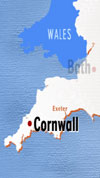Heligan is one of the great archaeological discoveries in horticulture. Created mainly in the 19th century by three generations of the Tremayne family, it included 57 acres of gardens, 100 acres of woodland and 300 acres of rides. Henry Hawkins, John and John Claude Tremayne were noted botanists and horticulturists, and by 1900 had a huge collection of trees and shrubs from all over the world.
With the outbreak of World War I, Heligan House was taken over by the War Office. It was returned to the Tremaynes in 1919, but they rented the house and the gardens were not maintained. During World War II, the US army was allocated the house. In 1970 the Tremaynes sold the house as flats. Although the gardens remained in the ownership of the Tremaynes, they were neglected. The gardens were ‘lost’ as they became overgrown with ivy, bramble and laurel in the years from 1914 until 1990.
Restoration
In February 1990, Tim Smit and John Nelson met John Willis, the Tremayne family member who had inherited the gardens. This chance meeting was the beginning of a whole new chapter in Heligan’s history. Smit and Nelson leased the gardens, researched their history and raised money to restore them.
In 1991 the restoration began. A team of workers hacked their way through mountains of brambles and ivy and discovered long forgotten orchid houses, vineries, peach houses and even a pineapple pit. Buildings discovered in the garden gave many clues on the way gardening was done in the 19th Century.
The gardens were remodelled in the Victorian tradition, with special emphasis on the walled kitchen garden. It has now become the only working 19th Century garden in Britain, producing peaches, melons and even pineapples.
Productive gardens
Four walled gardens, complete with glasshouses, frames and pits, produced the flowers, fruit and vegetables for Heligan House. The Melon Garden contained pineapple pits and melon frames. The Melon House was built in about 1720, and was heated by a boiler with pipes running under the beds.
The skills involved both in the restoration of the pineapple pits and in producing ripe fruit were also ‘lost’. It took the team four years to learn how to control the humidity and the heat from rotting manure and fermenting bark, to ensure optimum growing conditions. The pineapple pit is now in operation all year round, and Heligan is producing over 300 varieties of fruit and vegetables by traditional methods.
Italian garden and ravine
This garden, with its summer house and formal pool, was inspired by the discoveries being made at Herculaneum and Pompeii. A ravine or rockery more than 100 yards long runs out of the Italian garden. This was Lord Tremayne’s attempt to create a mountain walk to remind him of Italy.
Giant rhododendron
Flora’s Green, a lawn used by the ladies for dancing, was surrounded by a collection of rhododendrons brought back from the Himalayas between 1847 and 1849 by the famous plant collector, Sir Joseph Hooker. Here, Don was amazed to see what is believed to be the largest rhododendron in the world, a ‘Cornish Red’ variety measuring 82 feet from bowl to tip.
Jungle
The jungle was created in the 1800s to house the largest collection of tree ferns in Europe, palms, bamboo, a banana plantation and other exotic trees and shrubs. Tree ferns (Dicksonia antarctica) were sent to Cornwall from Australia, and arrived as ballast on the quayside at Truro. Most came from New South Wales and they thrived in Cornwall’s mild climate.
Further information
The Lost Gardens of Heligan
Pentewan, St Austell, Cornwall
Website: www.heligan.com
Email: [email protected]
Open all year except Christmas Eve and Christmas Day.



